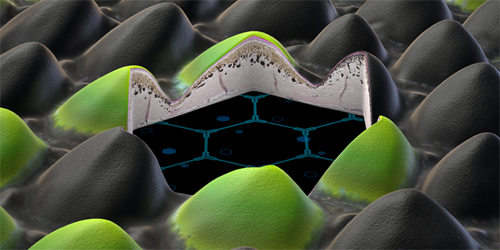Model Reveals Reptilian Scale Pattern
A leopard can’t change its spots, but certain lizards change theirs as a matter of course. The scales of an ocellated lizard, for example, switch back and forth between green and black as the lizard matures, before settling on a labyrinthine arrangement with short-range order. By modeling the dynamics of this process, Szabolcs Zakany and Michel Milinkovitch at the University of Geneva have discovered that the seemingly binary configurations of scales hide a secondary pattern based on color gradations too subtle to see with the naked eye [1]. These results show that biology, despite its “messy” nature, can sometimes be efficiently and quantitatively investigated mathematically, Milinkovitch says.
Zakany and Milinkovitch have previously studied the development of ocellated lizards’ scale patterns using two different lattice-based models (see Synopsis: Lizard Scale Patterns Described with Antiferromagnetic Model). Those models, in which scales are restricted to two discrete states (green or black), were well suited to such investigations, as the animals’ tissue morphology makes their scales behave like sites on a lattice. In the researchers’ new work, they employed a continuous-state reaction–diffusion model similar to that proposed by Alan Turing in 1952. The way the lizards’ scales are structured effectively imposes spatial discretization on this model. But now each scale can “choose” from a continuum of shades, depending on interactions with its neighbors.
Starting with random configurations, this model predicts stable arrangements of green and black scales akin to those produced by the discrete-state models. But whereas in the discrete cases, the color choice was binary, in the reaction–diffusion model, each apparently single-colored cluster contains subclusters of slightly different hues. These subtle secondary patterns were previously unknown in ocellated lizards, but Zakany and Milinkovitch used hyperspectral imaging to confirm that the patterns exist on real lizards.
–Marric Stephens
Marric Stephens is a Corresponding Editor for Physics Magazine based in Bristol, UK.
References
- S. Zakany and M. C. Milinkovitch, “Simple reaction-diffusion modeling predicts inconspicuous neighborhood-dependent color subclustering of lizard scales,” Phys. Rev. X 13, 041011 (2023).




